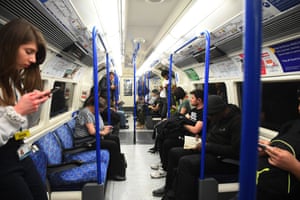Back to business is on the cards … but how might it actually work?
Temperature tests, taped-off lifts and potential spikes in harassment complaints are all being examined by British businesses as they prepare for a slow and staggered return to work.
Companies have already been scrambling for legal and practical advice as they prepare for the realities of managing workplaces during the Covid-19 crisis. However, there are already major concerns that workers are unclear about what to do if they are being put at risk, while industry figures also warn that the mental health impacts of returning to a new “alien environment” are not being prioritised.
Taped squares in lifts, protective screens between workstations and repurposed meeting rooms are among the basic measures being prepared. A surprisingly wide range of businesses are said to be considering more drastic action, such as the introduction of temperature tests for staff on arrival, according to employment lawyers. Such testing is fraught with potential issues. The enforcement of testing – and recording whether or not a staff member has contracted coronavirus – are areas that could be tested in the courts.
UK workplace rules after lockdown may include extensive hygiene measures
An increase in whistleblowing complaints is also likely, as workers see different employers taking different approaches to the loosening of lockdown – a tension created by differing interpretations of government guidance.
Kevin Rowan, the TUC’s head of health and safety, warned that a huge public awareness campaign was needed to ensure workers know their rights. “What is the public information message so that people know what employers are required to do, and that there is somewhere they can go to complain?” he said. “We need to make that more transparent, as well as boosting enforcement.”
There are also warnings of a spike in sexual harassment and other harassment allegations as employees readjust to life in the workplace, with some social distancing rules likely to remain in place.
A memo composed by a London-based team at the law firm Morgan Lewis warns: “Employers may face a spike in employee misconduct, grievances and litigation as employees adapt to their new workplaces following the long period of isolation. For example, employers may see an increase in sexual harassment issues as employees return to the workplace, and other harassment complaints where employees fail to respect personal space or comply with safety guidelines.”
Meanwhile, business groups warn any significant return to work is entirely reliant on the reopening of schools and childcare. Adam Marshall, director general of the British Chambers of Commerce, said: “To say to an employer that schools are going to be open for a couple of year groups on alternate days for a few hours at a time does not solve the problem of getting people back to work.”
The government is also being warned to take the psychological impacts of the lockdown as seriously as the logistical difficulties. “We don’t think what we’ve seen so far recognises the emotional impact and anxiety that people will have of what is essentially an alien environment that some people will be returning to,” said David D’Souza, a director at the Chartered Institute of Personnel and Development.
The journey to work

Both unions and employer groups have told the Observer that the main concern cropping up over the potential return to work is the commute. Employers will be urged to stagger shifts and start times far more to help ease the pressure on traditional peak-time services.
“At the start of the pandemic, we were seeing pictures of congested trains,” says Rowan. “While that has eased a lot, there are still pretty regular concerns.”
Public transport bosses have warned that current social distancing rules would see them operating at 20% capacity or less, causing obvious concerns about those rules being breached or cars clogging up cities.
Face masks could allow public transport to be used in greater numbers. In Berlin, wearing masks on public transport is compulsory and social distancing is not required. However, the effectiveness of masks remains disputed. Measures have been taken overseas to reduce congestion in bus and train stations, but they are crude – usually in the form of painted lines denoting the correct social distancing space.
Walking and cycling are being advised for some workers and there has been a major increase in bike-purchasing schemes. Temporary bike lanes are being considered in the UK.
Arriving

Testing upon arrival at work is being considered, with temperature tests the most practical and least invasive. “Interest is wider than you would think,” says Matthew Howse, who runs Morgan Lewis’s employment practice team in London. Taping-off lifts to ensure safe social distancing is also being used, while companies have already thought about one-way systems in and out of buildings, as well as hand sanitiser stations at entrances.
A major change in shift patterns may be needed to prevent the morning bottleneck. “It would be helpful if your workforce actually phased the shift rota so they arrive over a two or three-hour period,” says Duncan Spencer, the former head of safety and health at John Lewis and now head of advice and practice at the Institute of Occupational Safety and Health. “You could have an A and B shift, with some working from home.”
Many industry figures said the only realistic way to ensure social distancing was keeping high numbers of workers at home or continuing with a state job retention scheme, paying employees not to work. “There are things that employers can do, but you can’t just turn the tap off on the job retention scheme because it may be that only a third of workers can go back to work and be safe,” says Rowan.
Workstations
Advice on protecting workers has already been issued to companies that were allowed to stay open during the pandemic, such as the introduction of physical screens between workers. In offices, communal spaces such as meeting rooms will be repurposed, to spread out desks. Having workers face in opposite directions has already been advised.
Extra cleaning of frequently touched surfaces, from hand rails to photocopier buttons, is another simple measure – with many companies updating their contracts with cleaning staff.
Once the easier measures have been completed, companies are left with what occupational health experts describe as the last resort in the “hierarchy of risk” – personal protective equipment (PPE). Its use comes with many issues, such as ensuring it is used correctly.
“More simply,” says D’Souza, “if you think there is that level of risk, should you be asking people to return at all?”
Businesses do not want to end up competing with the NHS for supplies. “They don’t want to be going out in the market in a free-for-all,” says Marshall. “The importance of a national PPE procurement strategy that takes into account a healthcare system’s needs and the demand from businesses is hugely important.”
Lunch
Existing government advice suggests the staggering of staff access to the canteen, but in many cases that may render the facility impractical. “I don’t believe there will be any great desire to reopen staff canteens in the first wave of unlocking,” says Mark Laurie, the director of the Nationwide Caterers Association.

“Logistically, it will prove challenging and it may be safer and more prudent to work with a ‘roundsman’ to bring food to serve or cook onsite from an outdoor mobile unit. Some of the buildings may make it near impossible to adhere to social distancing within the kitchens or customer areas.”
Companies allowing food to be delivered will need to consider the extra hygiene and contamination precautions. Ministers are already encouraging takeaway outlets to reopen, but social distancing rules will leave many workers wondering if they should spend their lunch break in a queue or bring something with them.
Laurie wonders if it will lead to an increase in the quality of the homemade lunch. “We may see a flourish of creativity in people’s lunch boxes if homecooking has taken off during lockdown.”
Meetings
Existing guidance already tells businesses to limit the length of face-to-face meetings, if they have to happen at all – 15 minutes or less has been the advice to some sectors.
Videoconferencing has already allowed businesses to continue during the lockdown and that enforced technological take-up is likely to be relied upon for months. “Things are working well with staff at home,” says Marshall. “Businesses have experienced what in normal times would be a five- to 10-year shift to new ways of working in five weeks.”

Others are warning that it is that interaction with colleagues that many workers are craving – and the realities of the return to work could have a significant psychological impact. “For some people there is almost the comfort blanket of thinking about the return to the traditional working environment, with the buzz of being around colleagues, the camaraderie and the social benefits that come with being in work,” says D’Souza.
“It’s really unlikely in the short term that any workplace is going to feel anything other than unsettling and very sterile. Organisations are having to wrestle with these things like never before, and there are no hard and fast correct answers. That makes it more important not to rush back.”
‘We won’t force anyone to come in and take a risk if they are uncomfortable with it’

One boss, Dale Vince of Green energy firm Ecotricity, explains how he will get his 700 staff back to work
Almost all the desks at Ecotricity’s headquarters in Stroud are empty. Pot plants, cards and personal photos are the only signs of the hundreds of employees at the green energy firm who used to file in and out of the building in the Cotswold town every day.
Like most office-based employers, the firm’s founder, Dale Vince, sent virtually all of his 700-strong workforce home at the start of the lockdown in March. Now he is considering how to bring some of them back in anticipation of government guidance for reopening non-essential businesses.
He admits that the Gloucestershire company is unlikely to return to the days of routine face-to-face meetings and rows of staff chatting across computers. “I don’t want to rush back into ‘business as usual’. Some of our functions have worked really well during the lockdown,” he says in his glass-plated office.
“I’m hoping we will be able to sell two of our three offices in Stroud. We will then space ourselves out in this one and a new one over the road. We’ll operate a cycle of working from home and from the office, where we will arguably end up with half as much space.”
Halving the number of people in the office at any one time will allow staff to keep their distance and avoid sitting opposite each other. “We will be giving everyone more space,” he says.
Vince, who spent 10 years as a new age traveller before launching the UK’s first green electricity company, believes that now is the right time to plan the reopening of workplaces. However, he acknowledges that his workers will face a degree of risk when they return. “If we are going to exist in lockdown, we are going to have to take some risks,” he says. “The reality is that the virus hasn’t gone away and there’s no vaccine, but we’re going to live in the gap in between.”
Staff who are worried or have vulnerabilities will be under no pressure to go back to their desks. “We will not be forcing anyone to come in and take a risk they are not comfortable with,” he says.
Vince, 58, has also been thinking about how to restart his other diverse interests, including a wind turbine factory, a kitchen making vegan school meals, and the country’s only vegan football club, Forest Green Rovers.
“Football is probably the least of the issues because games played behind closed doors are very controllable,” he says. “Putting people back into office spaces, back on the roads, back into town – that’s much harder to control.”
Ecotricity has seen its turnover fall by about 20% as commercial power consumption has dropped, but Vince says all his workers, including the 50 employees furloughed on 100% of their wages, have nothing to worry about. “They will definitely come back to jobs,” he says.
There are some positive lessons to be learned from the country’s mass home-working experiment, with traffic down and emissions reduced. But Vince acknowledges that people still need offices. “People don’t want to work from home all the time – it is too isolating,” he says. “We can get the best of both worlds by cycling from one to the other.”
Source: Read Full Article

